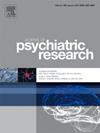Investigating DTI-ALPS index and its association with cognitive impairments in patients with alcohol use disorder: A diffusion tensor imaging study
IF 3.7
2区 医学
Q1 PSYCHIATRY
引用次数: 0
Abstract
Background
The glymphatic system, a physiological pathway recently identified, has attracted considerable attention for its potential role in the pathophysiology of neurological disorders. Despite significant research efforts, the exact contribution of the glymphatic system to alcohol use disorder (AUD) remains largely elusive. This study was a secondary analysis by analyzing a subset of the original data to examine changes in the ALPS index and determine its association with cognitive abilities in individuals with AUD.
Methods
We recruited 40 individuals with AUD and 40 healthy controls (HC). All subjects underwent MRI scans and clinical cognitive scale assessments. Diffusion tensor imaging along the perivascular space (DTI-ALPS) index was used to estimate the differences in glymphatic activity between both groups, and linear regression analysis was used to examine the association between ALPS index and cognitive performance measures.
Results
A statistically significant difference in the ALPS index was observed between both groups (p < 0.001), with the AUD group showing statistically lower ALPS index compared with the HC group (p < 0.001). Additionally, a positive correlation was identified between the ALPS index and MoCA/MMSE scores, indicating that higher ALPS index is indicative of better cognitive performance in individuals with AUD.
Conclusions
The findings of this study provide evidence of ALPS index in individuals with AUD and establish a link between the ALPS index and the cognitive impairments observed in AUD patients. These findings might suggest the importance of glymphatic activity in the emergence of cognitive deficits among those impacted by AUD, but a stronger link between ALPS index and glymphatic system is needed to better understand the relationship between glymphatic function and healthy outcomes.
调查酒精使用障碍患者的 DTI-ALPS 指数及其与认知障碍的关系:扩散张量成像研究
背景:glymphatic 系统是最近发现的一种生理途径,因其在神经系统疾病的病理生理学中的潜在作用而备受关注。尽管开展了大量的研究工作,但甘泳系统对酒精使用障碍(AUD)的确切影响在很大程度上仍然难以捉摸。本研究通过分析原始数据的一个子集进行二次分析,以检查 ALPS 指数的变化,并确定其与 AUD 患者认知能力的关联:我们招募了 40 名 AUD 患者和 40 名健康对照组 (HC)。所有受试者都接受了核磁共振成像扫描和临床认知量表评估。我们使用沿血管周围空间的弥散张量成像(DTI-ALPS)指数来估算两组患者的肾上腺活动差异,并使用线性回归分析来研究ALPS指数与认知能力指标之间的关联:结果:两组之间的 ALPS 指数差异具有统计学意义(P本研究结果提供了 AUD 患者 ALPS 指数的证据,并确定了 ALPS 指数与 AUD 患者认知障碍之间的联系。这些发现可能表明,在受 AUD 影响的人群中,肾上腺活动在认知障碍的出现过程中起着重要作用,但要更好地理解肾上腺功能与健康结果之间的关系,还需要加强 ALPS 指数与肾上腺系统之间的联系。
本文章由计算机程序翻译,如有差异,请以英文原文为准。
求助全文
约1分钟内获得全文
求助全文
来源期刊

Journal of psychiatric research
医学-精神病学
CiteScore
7.30
自引率
2.10%
发文量
622
审稿时长
130 days
期刊介绍:
Founded in 1961 to report on the latest work in psychiatry and cognate disciplines, the Journal of Psychiatric Research is dedicated to innovative and timely studies of four important areas of research:
(1) clinical studies of all disciplines relating to psychiatric illness, as well as normal human behaviour, including biochemical, physiological, genetic, environmental, social, psychological and epidemiological factors;
(2) basic studies pertaining to psychiatry in such fields as neuropsychopharmacology, neuroendocrinology, electrophysiology, genetics, experimental psychology and epidemiology;
(3) the growing application of clinical laboratory techniques in psychiatry, including imagery and spectroscopy of the brain, molecular biology and computer sciences;
 求助内容:
求助内容: 应助结果提醒方式:
应助结果提醒方式:


